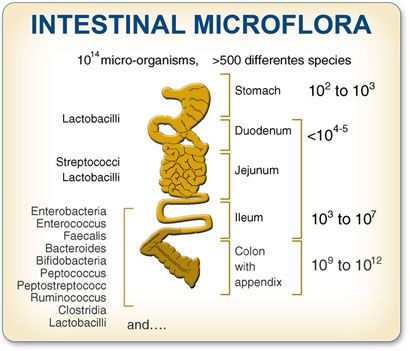Gut Flora consists of microrganisms that live in the digestive tracts. Recent insight suggests that the intestinal microbial flora could play an important role in obesity and its related diseases. The human intestine harbors an enormously complex, diverse, and vast microbial community, referred to as gut microflora or microbiota. The human gut microbiota is estimated to consist of at least 1014 bacteria and archaea, composed of approximately 1100 prevalent species, with approximately 160 such species per individual. In its entirety, the microflora is estimated to contain 150-fold more genes than our own host genomes. Apart from contributing substantial beneficial functions to the host (e.g., digestion of otherwise indigestible plant polysaccharides), this separate ecosystem has enormous potential for physiological and pathological interactions with the host; for example, the microbiota can drive the development of the mucosal and systemic immune system and controls the regeneration of the intestinal epithelium.
The composition of the microbiota, which is normally acquired during and shortly after birth, is relatively plastic during early development but, once stabilized, is thought to maintain many of its characteristics throughout the life of the host.

Modern molecular techniques have disclosed a tight relationship between mammalian gut microbial composition and function and host metabolism. This relationship can eventually contribute to the development of metabolic disease, including obesity, NAFLD (Non Alcoholic Fatty Liver Disease) and diabets. The gut microbiota may predispose to obesity and associated disorders through a series of interactions with the host that lead to the modulation of:
- Carbohydrate metabolism
- Fatty acid composition
- Bile-activated metabolic pathways
- Dietary choline bioavailability
- Host fat storage
- Energy homeostasis and metabolism
Interactions between gut microbiota and host metabolism predisposing to obesity and diabetes.
Some studies have indicated that an altered gut microbiota is associated with several diseases that are particularly prevalent in the 21st century. For example, reduced microbial diversity (a sign of a dysfunctional ecosystem that leads to a decreased stability of the microbiota) has been associated with both inflammatory bowel disease and obesity. The first studies on the relationship between the composition of the gut microbiota and obesity have shown that the number of Firmicutes was increased whereas the number of Bacteroidates was reduced in obese mice and humans compared with lean individuals.
Interestingly, weight loss achieved by dieting was able to reverse those changes.
Microbial ecology: Human gut microbes associated with obesity.
The development of obesity and the metabolic syndrome is a complex process involving genetic and environmental factors and is associated with pathways that connect metabolism with the immune system and vice versa. Important studies on the relationship of the intestinal microbial flora with obesity have uncovered profound changes in the composition and metabolic function of the gut microbiota in obese individuals, which appear to enable the "obese microbiota" to extract more energy from the diet. Moreover, the gut microbiota interacts with host epithelial cells to indirectly control energy expenditure and storage.
An obesity-associated gut microbiome with increased capacity for energy harvest.
The major cause of obesity is a positive energetic balance resulting from an increased energy intake from the diet and a decreased energy output associated i.e., with low physical activity. In addition, the genetic background participates to the inter-individual difference in term of energy expenditure and storage capacity. However, growing evidence suggests that among the “external” factors contributing to the host response towards nutrients, the gut microbiota represents an important one. The gut microbiota composition/activity is a factor to take into account when assessing the risk factors related to obesity, but also to associated diseases, such dyslipidemia and atherosclerosis, insulin resistance and diabetes, hepatic steatosis and steatohepatitis (NASH).